Blog Archives
November 26, 2003 
Gurudeva some years ago with the latest iBook computer. He always encouraged the monks to keep up-to-date with the latest tools, while being careful to make sure the kept their proper place in our lives.
"The computer is just like the mind. It has memory, a certain amount of reasoning ability, a certain motivation. But it doesn't have the controls that you, as a human, are able to exert within yourself, such as willpower and the power of viveka, discrimination, which is so central to our religious tenets. Therefore, ask yourself, what is spirituality to you? What is important to you? What do you want to impress in your inner mind to perhaps manifest in this or your next life? You can use these tools to enhance what is important to you, and thereby benefit not only your own life but the lives of others. "
Our Beloved and Revered Satguru Sivaya Subramuniyaswami
Attained Maha Samadhi on November 12th, 2001
Click to read for Details.
We are pleased to announce the web release of Satguru Sivaya Subramuniyaswami's monumental work on Hindu culture and lifestyle:
Living with Siva.
Click here for the entire text and artwork, now on-line!
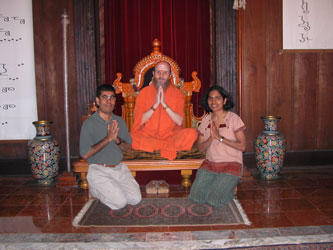
Devotees of Paramahamsa Hariharananda, Amar and Deepa Subramanian from New Jersey. Today was their first visit to Kauai Aadheenam and they were very excited to meet with Bodhinatha, and really overwhelmed with the vibration of Kadavul Temple.
Bodhinatha's Sun One Video. Most Recent update: September 12, 2003. Bodhinatha speaks on Ahimsa, noninjury, yama #1, which is noninjury in thought, word and deed. The law of karma decrees that it is wise not to harm or hurt others, for we will then receive harm and hurt in exchange in the future. 12 minutes, 29 seconds.
 |
|
|
|
Live Web Cam Pix! |
 |
||||
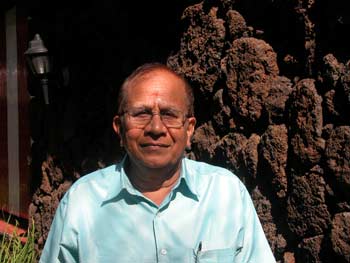
Krishnamoorthi, also from New Jersey. He met Gurudeva in 1999 at the Kumbhabhishekam of the Maryland Muruga temple.
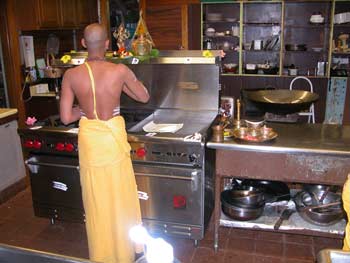
We finally got a new stove -- gas cooking range -- in the kitchen. Our old stove was very old... at least 20 years!
The traditional blessing is given for this new and important addition to the kitchen. Yogi Mahadevan performs the ceremony.
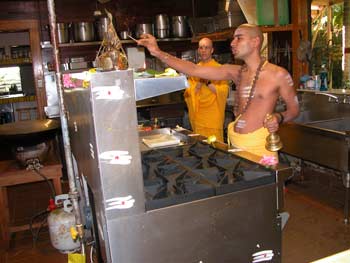
This new model has six burners, a side griddle, just perfect for dosai and chapatis. The first dish prepared on the new stove was sweet kesari for dinner.
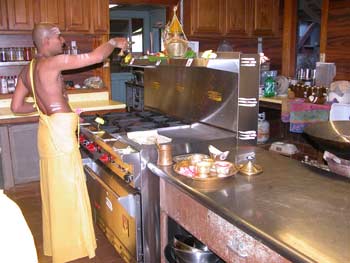
The stove has two ovens. One is a conventional oven and the other is convection oven that circulates the heat evenly throughout the oven. This helps to make sure that the baked goods cook evenly throughout the oven and nothing is over or under baked. There is a rumour going around today that the oven initiation will be tonight with home made chocolate chip cookies.
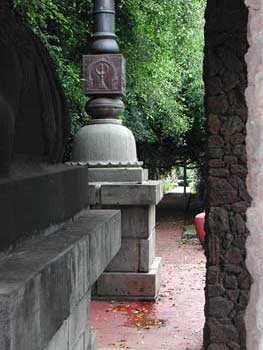
Looking out from Kadavul Hindu Temple past the Kodimaram down the path of Tiruneri....
 The Remarkable Vision |
Iraivan Temple Progress Update |
Join this historic undertaking. Please contribute generously. Sponsor a stone today! |
| Order Rudraksha Malas from Siva's sacred Hawaiian groves; and also single rudraksha beads ready to put on a chain around your neck. Great for Gifts! All proceeds go to the building fund. | ||
|
Current Overview  |
||
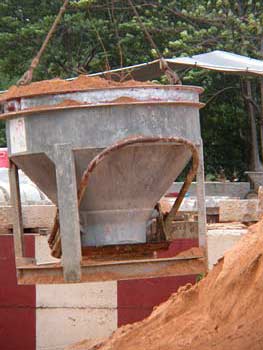
We had a lot of photos from our last crane lift day so we have kept some aside for today. Aside from stones, the crane helps make light work of loading up the sand that is poured into the center of the sanctum during construction. our team fills this bucket up with the Bobcat and then up he goes!
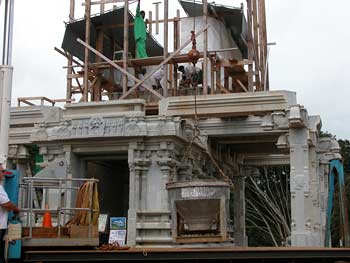
Yoginathaswami topside, supervising the whole operation very carefully. He has a big responsibility.
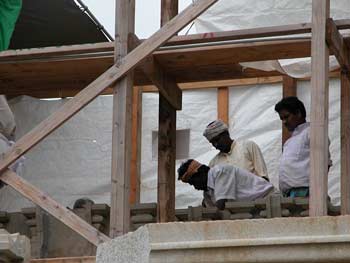
Three silpis aloof are ready to receive the sand.

The load is dumped into the center and the silpis smooth it out. This will later be a hollow space in the vimanam above the crystal Sivalingam.

Silpi Adaikan
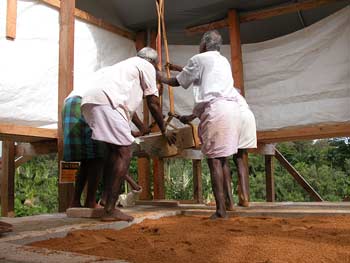
A stone beam arriving through the opening at the top.
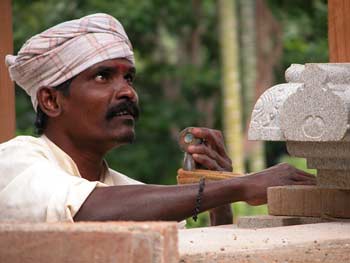
Silpi Karuppaiah

Silpi Chinnu
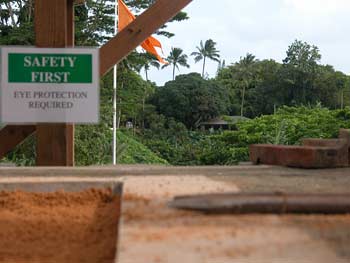
From atop the temple we can see all the way across the river valley to the publications office.
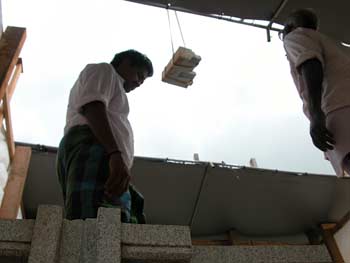
More small stones arriving.
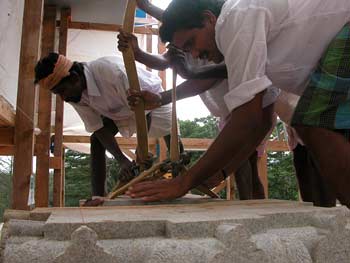
Unstrapping....
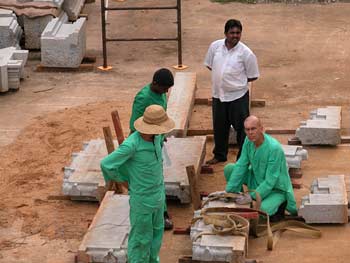
The ground team has another stone rigged and waits quietly for the team above to finish.
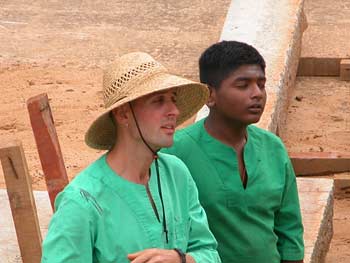
Thambynathan Girish Samugam and Sadhaka Tejadeva.
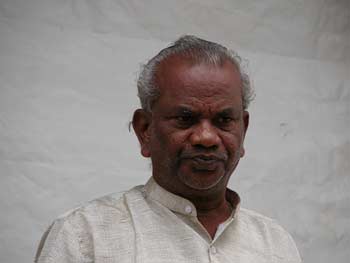
Sthapati enjoys the lift... carefully directing his team, his months of planning manifesting...
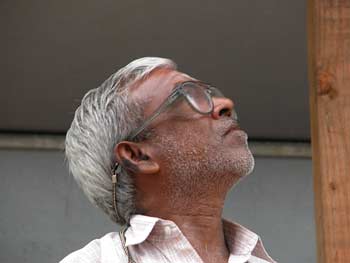
Silpi Sankaran
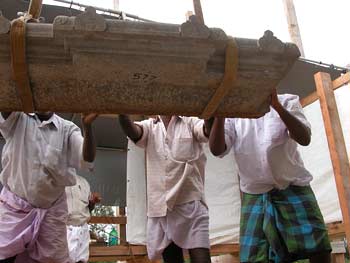
A large stone arrives.
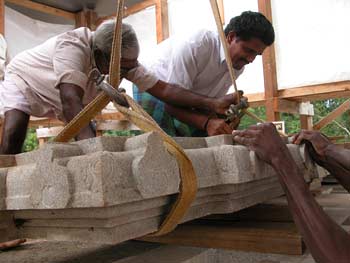
These are all for course 19 which has been completed as we write.
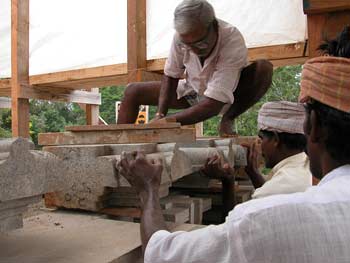
Getting the stone roughly in position while the crane goes down for more.
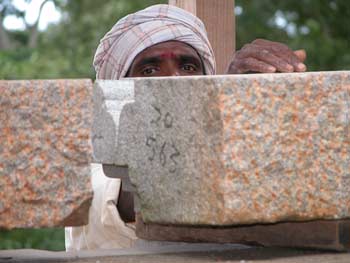
Each stone is marked in India according to the master plans of the designing architect, Ganapati Sthapati.
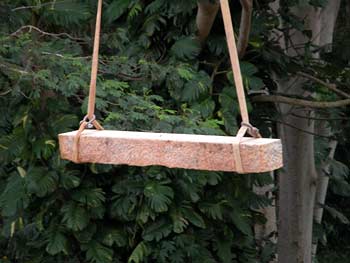
A beam for the inner wall.....
![]()
Saiva Siddhanta Church
Singapore Mission
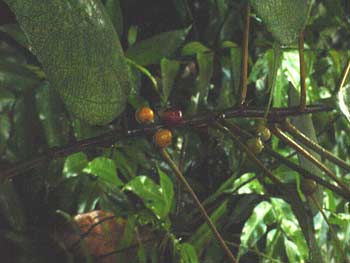
We continue with the story of the Singapore Mission members nature sent to us by Thamilmani Visakan of Singapore:
The fruits of another rare plant in the Singapore Botanic Gardens.
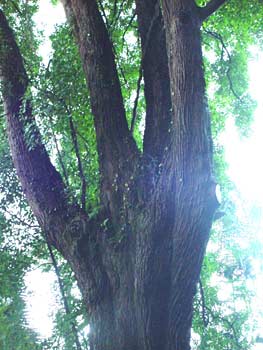
Tembusu, tall and impressive tree is hardy but slow growing. The long lived, evergreen Tembusu can grow up to 25m and can live up to 150 to 200 years. Its wood is very hard and resistant to rot and termites. It can be used for making bridges, rafts, chopping boards, furniture, and house building. The creamy white flowers turn yellow with age. Flowers are very fragrant especially in the evening.
This tree has been identified as a heritage tree and is featured on the Singapore $5 currency note and in postage stamps.
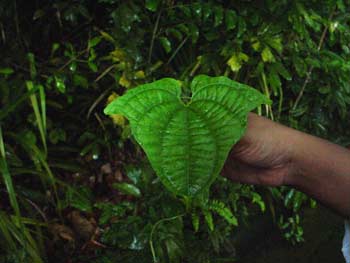
The batman (called so because of the shape) grows on tree trunks or branches of living trees in the rainforest. During pruning this creepers are pulled out to
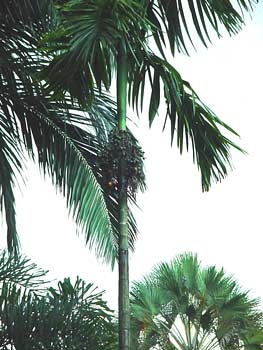
The betal nut tree, the betel nut, made from slices of betel palm seeds smeared onto a betel pepper leaf together with other aromatic flavorings and limes paste and rolled up. The betel palm and the betel pepper are native to and widely cultivated in South East Asia, where betel has been chewed since ancient times and is an article of considerable commerce. Betel contains a stimulant and may have some medicinal value.
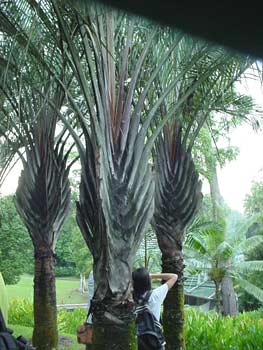
Triangle palm tree. This is another unique tree that captured our eyes.
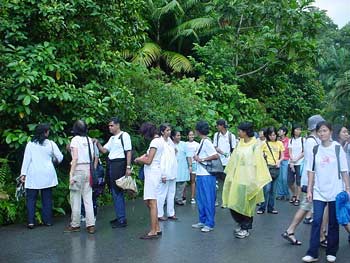
Mr Umamaheswaran, who majored in Zoology and ancillary in Botany and Chemistry, shared his knowledge with our guide. He was relating the plant names in Tamil for our better understanding and he gave us infos about the plants. Thank you ayyah for sharing your knowledge with us. Your explanation in Tamil is very much appreciated by all of us.
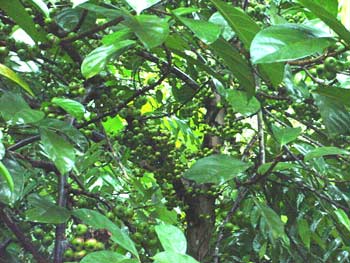
The fig tree originates from the region round the Mediterranean sea where the fruits have been eaten since b.c. The fig tree with edible fruits (Ficus carica), is as most of fruits the result of a crossing between different botanical species. Depending on its parentage, the plant develops itself as a small bush or a large tree. The fig tree bears succulent and colourful fruits. They are yellow, blue, green, red, brown, grey, black or been combination of all these colors. The fig fruit grow either amongst the tree crown, out of the main stem or on ground level runners. This variability allows the fig species to attract different seed disperses, thereby avoiding competition with each other for the fruit eaters' attention. Fig fruit eaters are equally diverse and include fruit bats, primates, treeshrews, squirrels, deer and over 50 species of bird.
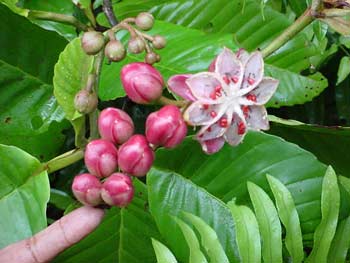
The reddish pink fig fruits.
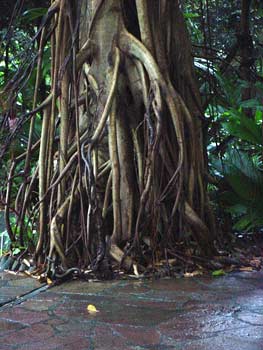
The strangler fig is an amazing tree, which starts life as a tiny seed in the canopy. The roots grow down to the forest floor where they take root and begin to take nutrients from the soil. Gradually the roots wrap around the host tree, widen, and slowly form a latticework that surrounds the host's trunk. The fig's crown grows foliage, which soon overshadows the tree. There are about 800 species of fig trees throughout the world. About 300 of them are stranglers. These long vines hang down from trees in the canopy and are called lianas or bush ropes. These plants are strong enough for a person to climb on and some are 500 feet long.
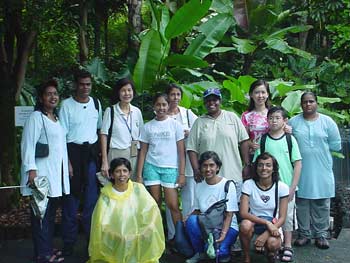
Last but not least, many of the foods we eat today originated in rainforests: avocado, banana, black pepper, brazilian nuts, cayenne pepper, cassava/manioc, cashews, chocolate/cocoa, cinnamon, cloves, coconut, coffee, cola, corn/maize, eggplant, fig, ginger, guava, herbal tea ingredients (hibiscus flowers, orange flowers and peel, lemon grass), lemon, orange, papaya, paprika, peanut, pineapple, rice, winter squash, sweet pepper, sugar, tomato, turmeric, vanilla and etc. The wild strains still in the rainforests of many of these plants provide genetic materials essential to fortify our existing agricultural stock. One fourth of the medicines available today owe their existence to plants. Seventy percent of the plants identified by the National Cancer Institute as useful in cancer treatment are found only in the rainforest. Drugs used to treat leukemia, Hodgkin's disease and other cancers come from rainforest plants, as do medicines for heart ailments, hypertension, arthritis and birth control. Yet fewer than 1% of tropical forest species have been thoroughly examined for their chemical compounds.
Seen here is the mighty and outstanding group who enjoyed their walk in the small rainforest. They were flushed with some knowledge about plant and their benefits.
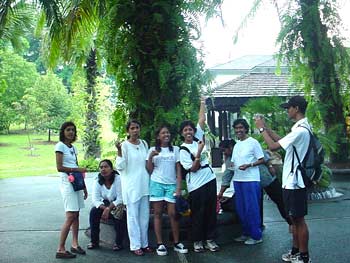
After the walk, we had little snacks prepared by Suselah. Then we chat for a while before we went back home with lots of GREEN memories. Such outings enrich us and put us back in the right frame of mind to face the challenges of urban life. A day with nature is always wonderful!
No Audio Today
|
Be surprised! Take this opportunity for an adventure. Close your eyes and click to get a message picked at random from the vast audio archives of our Satgurus' discourses |
And click here for an Index to All Past CyberTalks.
|
|
MORE UPLIFTING THINGS |
2004 Indian Odyssey
Join Satguru Bodhinatha Veylanswami on an 18 day Innersearch to South India, from Jan 19 to Feb 5, as we pilgrimage to ancient monasteries, magnificent 1,000 plus year old sacred temples and meet with India's holy men in a life-transforming adventure. Click on the above link for more details. |
|

|
Check our children and youth section for new items for the young and young at heart! | |
|
1. SIGN OUR GUESTBOOK and receive a FREE GIFT |
||
| 2. Newest Book: LIVING WITH SIVA | ||
|
3. Visiting KAUAI'S HINDU MONASTERY |
||
|
4. Contribute to THANK YOU, GURUDEVA FUND |
||